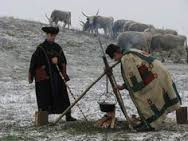Paprika
- audreymehl

- May 9, 2017
- 3 min read
I remember a class I took in university about women in American history. We read this book about the changes cooking in America and its influence on society. Bold move, both for the author of the book and the professor who decided that this was a good book for a university student to be interested in during their last year of learning. I'm warning you now. If you don't care about cooking in history, don't bother reading on. Why did I write this blog then? Maybe I was inspired by the book I read in university, or maybe it's because food is one thing that brings every culture together. Face it, you love food too. You even love goulash. So, read. It won't take long, and it is sort of interesting.

What is goulash? It’s a soup or stew made with meat (usually beef or pork)
onions and paprika. You can also add potatoes, root vegetables and sometimes wine, bay leaf, caraway or thyme.
Where does the word ‘goulash’ come from? Well, lets just go with this. It came from Hungary, okay? Lots of people thought the word ‘Hungary’ came from these people descending from the Huns. The name was given to them during the medieval period. Latin speaking people, Proto-Slavic and Turkish people messed with the name several times before everyone settled on ‘Hungary’.

The word ‘goulash’ comes from the Hungarian word ‘gulyás’, pronounced with no ‘l’. It’s a word for a Hungarian Cowboy. You read about those last month! As the cowboys would go on cattle drives, they would butcher the weaker cows that wouldn’t live through the drive and make a stew from them. The plains of Hungary were the perfect places to raise cattle. They also sold their cattle all over Europe. Fortunately, the herdsman had great ingredients for their stew at hand. They used wild onions and caraway, which grew on the plains of Hungary. Since they went all over Europe, their dish went with them and became more popular, especially in Germany.
In the 1800s, it became important to the Hungarian people to protect their culture, language and their cuisine to strengthen national identity and independence from the Austrian Hapsburg rule. This is when restaurants decided to put goulash on their menu. By the second half of the twentieth century, it became the number one dish of Hungary.

According to a 1969 Gallup Poll, goulash was one of the five most popular meat dishes in America. Of course, sometimes people served dishes that they called goulash but it may not have been legitimate. Some people even called their casseroles a goulash. For Shame! How a Hungarian would cringe at the sight of macaroni noodles defiling their precious goulash! While Hungarians and Americans fight over what real goulash is, one thing unites them, and that is paprika.

The two most popular spices in the world are black pepper and paprika (red pepper), although Hungarians use the word ‘paprika’ for both bell peppers and chili peppers. Germany, and most of Europe loved their black pepper that was mostly grown in India. In the 15th century the Ottomans from Turkey conquered most of Eastern Europe and so the trade rout to India was cut off, and so was their black pepper. While Columbus was exploring Central America, he discovered the chili pepper that tasted close to the black peppercorn. He brought this pepper back, but it didn’t really catch on. These peppers were more than likely used just for ornamental purposes in gardens. The Turks, who traded with most of Europe, found it agreeable to use in their foods and took it wherever they traded and conquered.

The nearby Hungarians embraced the spice in their cooking. During the Napoleonic wars in the 1800s, black pepper became unobtainable, so the Turkish pepper became more popular. Hungarians began to coat their beef with ground, dried paprika, which preserved it when they didn’t have ice. Paprika has been popular in Hungary ever since.
Wow. I bet you didn’t know what an important blog post this would be. Well, you’re welcome. My time in Hungary is coming to a close. If you’ve been reading these posts from the beginning, thanks. I hope you enjoyed them. If you didn’t enjoy them, that’s your fault and you shouldn’t have read them.
See you this summer!
Comments